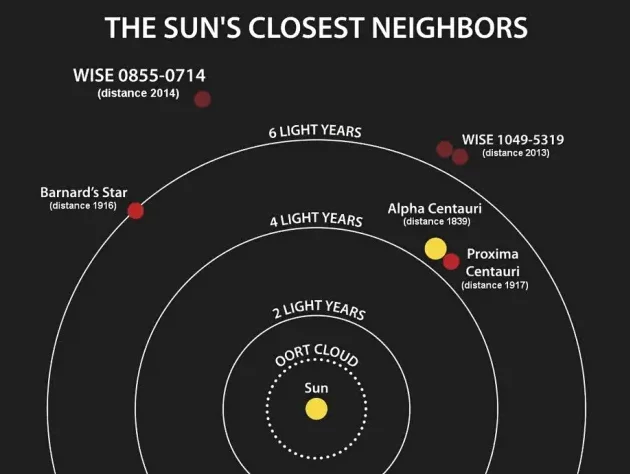Although it may appear trivial, the Sun is the closest star to the Earth. Therefore, the question is not entirely accurate. Our yellow dwarf is just as remarkable as other stars, and in fact, it is one of the most prevalent types of stars in the Milky Way. However, we are not discussing our own celestial body, so let’s examine which star is the closest to the Sun.
Many individuals are aware that Alpha Centauri is the closest star to us. Countless works of fiction have been dedicated to it, and this star is frequently referred to as our neighbor. Indeed, it is the nearest star to us, aside from the Sun. Nevertheless, the situation is not as straightforward as it appears.
The Nearest Star to Earth
Some meticulous individuals also refer to Alpha Centauri as Alpha Centauri. This constellation is formally known as Centaurus in Latin, which translates to Centaurus. However, the commonly used name for this star is Alpha Centauri. This is the name found in Russian literature, reference books, movies, and everywhere else. Although there may be debates among pedants regarding Centaurus vs. Centauri, such arguments hold no significance.
The Nearest Star to Earth is Alpha Centauri, which is located 4.37 light years away. It takes light this long to travel the vast distance between us at a speed of 300,000 kilometers per second. Therefore, proximity is relative, and humans may not be able to travel that far anytime soon, if ever.
Alpha Centauri is not just an ordinary star. It is actually a binary star system, consisting of two stars known as A and B. These two stars revolve around a common center of mass every 80 years, and at different times, one star is closer to us than the other. Although both stars are similar to the Sun, the A component is slightly brighter while the B component is slightly fainter.
When observed with the naked eye, both stars appear as a single star with a brightness of -0.27 m, making Alpha Centauri the third brightest star in the Earth’s sky.
However, the situation is more complex than that. Alpha Centauri, comprised of components A and B, is not currently the closest star system to us. There is another star, known as Proxima Centauri, which is also part of this system.
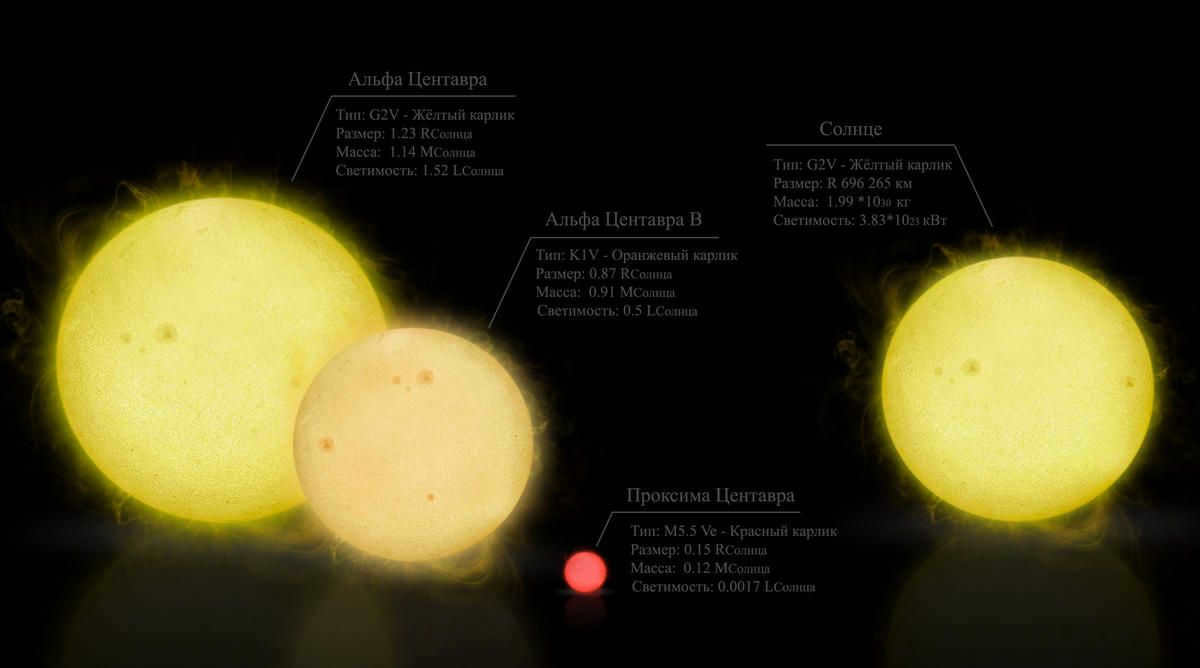
Comparison of the properties of Alpha Centauri’s stars and the Sun.
Proxima Centauri: the nearest star to Earth
Proxima Centauri is a red dwarf that is also a part of the Alpha Centauri triple star system. However, it is situated at a considerable distance from the two main and larger components of the system – 15,000 astronomical units, which is equivalent to 0.21 light-years. Interestingly, this distance is only 20 times shorter than the distance to Earth.
Due to its great distance from the center of the Proxima Centauri system, the star undergoes a turn in its orbit every 500,000 years. Currently, it is positioned in the orbital section ahead of Alpha Centauri, making Proxima Centauri the closest star to Earth for the next millennium. However, in the future, it will transition to a more distant part of its orbit, and the nearest star to Earth will be Alpha Centauri, specifically its components A and B.
Proxima Centauri, a red dwarf, is the closest star to Earth and is one of the components of the Alpha Centauri triple system.
In the sky, Proxima Centauri is located 2.2 degrees away from Alpha Centauri, which is equivalent to approximately 4 lunar disks. Despite its proximity, Proxima Centauri is not visible to the naked eye, as its brightness is only 11 m. Therefore, observation of this closest star can only be achieved through the use of a telescope, even a small one.
Despite being the closest star to us, it is incredibly dim. It is only 7 times smaller and lighter than the Sun. Even if it were observed from one of the planets in the Alpha Centauri system (if there are any), Proxima would still appear as a faint 5th magnitude star in the night sky.
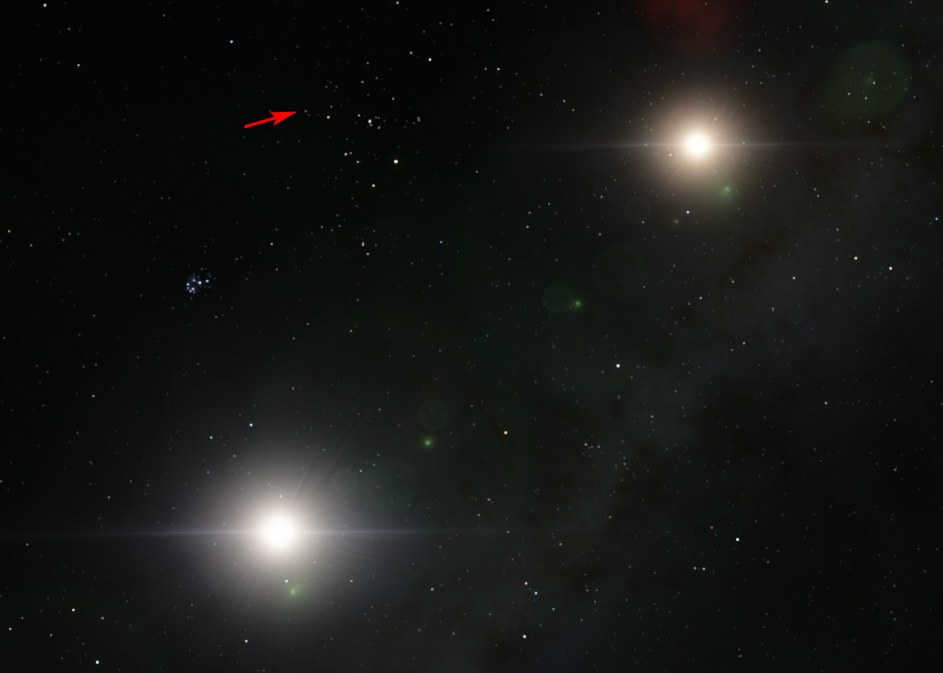
If we were close to the primary stars of Alpha Centauri, Proxima would appear as a faint star (indicated by the arrow) with a reddish color.
By the way, Proxima Centauri has a planet located in the habitable zone, which was confirmed to exist by the European Southern Observatory in 2016. This planet is relatively small and bears resemblance to Earth, as it is situated at a distance of 0.5 astronomical units from its star.
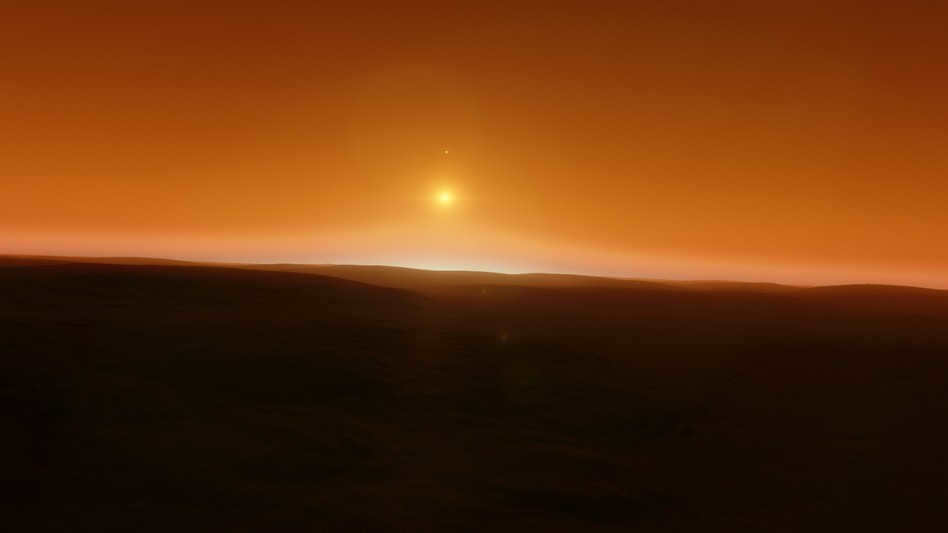

Proxima Centauri, the star closest to Earth, is depicted in this image. The image was captured using the Space Engine universe simulator.
However, the possibility of life existing there remains a highly debated topic. Proxima Centauri is an unstable red dwarf star that experiences periodic flares, resulting in increased levels of radiation, including X-rays. It is speculated that life, if present in the planet’s oceans, would be somewhat protected and could potentially adapt to the local conditions over time. Given that the star is approximately 5 billion years old, the potential for life cannot be entirely ruled out.
Furthermore, in 2019 there was a revelation about the detection of an additional celestial body in close proximity to Proxima Centauri, situated at a distance of 1.5 astronomical units from the star. This newly found planet possesses a mass that is at least six times greater than that of Earth and exhibits a frigid temperature of a mere 39 K. However, it is imperative to note that further investigations are required in order to validate the existence of this particular planet.
It is also speculated that Proxima Centauri harbors an asteroid belt. Although initial data suggests the presence of such a belt, comprehensive studies are still necessary to thoroughly explore this possibility.
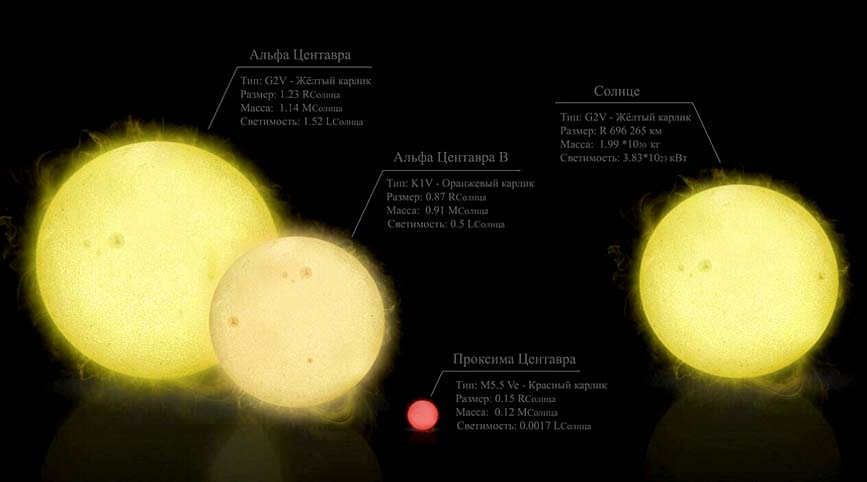

Our neighbors are the stars closest to the Sun.
The past and future closest stars to Earth
The positions of the stars change due to their movement, just like the solar system itself, and as a result, our neighbors change. Proxima Centauri and the entire Alpha Centauri system are only temporary neighbors. Over time, they will move away and other stars will become the closest.
For the past 32,000 years, Proxima has been the closest star to us. In another 33,000 years, the closest star will be Ross 248, which is located in the Andromeda constellation. It is now quite far away, at a distance of 10.3 light-years, which is twice as far as Proxima Centauri is currently.
In the observable Universe, there are approximately 10 trillion stars. Among these, our Milky Way galaxy contains around 200-400 billion stars. Each of these stars possesses unique characteristics such as size, temperature, apparent magnitude, and predominant matter composition.
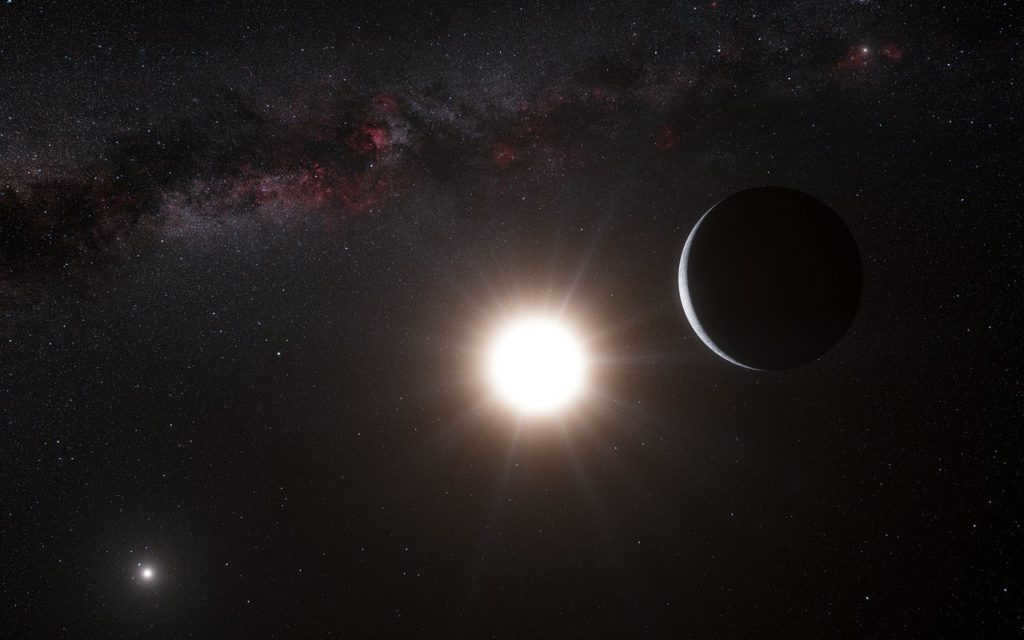
However, which star is the nearest to us? As much as it may sound like a cliché, the Sun happens to be the closest star to our planet. It falls into the category of the most common types of celestial bodies in our galaxy, known as a yellow dwarf. This article will shed light on other stars that are in close proximity to us, apart from the Sun.
Compilation of Nearest Stars to Earth
| No. | Stellar body | Star system/constellation | Apparent magnitude | Spectral classification | Distance (light-years) |
| 1 | Sol | Solar System | −26.72 ± 0.04 | G2V | 8.31 light-years |
| 2 | Proxima Centauri | Alpha Centauri | 11.09 | M5.5Ve | 4.244 |
| 3 | Barnard’s Star | Serpens | 9.53 | M4Ve | 5.96 |
| 4 | Luman 16 | Vela | 23.25 | L8 | 6.516 |
| 5 | Wolf 359 | Leo | 13.44 | M6V | 7.78 |
| 6 | Laland 21185 | Ursa Major | 7.47 | M2V | 8.31 |
| 7 | Sirius A | Canis Major | −1.43 | A1V | 8.6 |
| 8 | Sirius B | 8.44 | DA2 | ||
| 9 | Luyten 726-8 | Cepheus | 12.54 | M5.5Ve | 8.73 |
| 10 | Ross 154 | Sagittarius | 10.43 | M3.5Ve | 9.69 |
| 11 | Ross 248 | Andromeda | 12.29 | T6 | 10.3 |
| 12 | Epsilon Eridani | Eridanus | 3.73 | K2V | 10.52 |
| 13 | Lacaille 9352 | Piscis Austrinus | 7.34 | M1.5Ve | 10.74 |
| 14 | Ross 128 | Virgo | 11.13 | M4Vn | 10.91 |
| 15 | WISE 0350-5658 | Grus | 22.8 | Y1 | 11.20 |
| 16 | EZ Aquarii | Aquarius | 13.33 | M5Ve | 11.26 |
| 17 | Procyon | Canis Minor | 10.70 | F5V-IV, DA | 11.40 |
| 18 | 61 Cygni | Cygnus | 5.21 | K5V | 11.40 |
| 19 | Struve 2398 | Draco | 8.90 | M3V | 11.52 |
| 20 | Groombridge 34 | Andromeda | 8.08 | M1.5V | 11.62 |
This is a compilation of the nearest celestial bodies to our planet. Each of them possesses distinct characteristics and features, making it essential to examine them in great detail.
1. Sun
Undoubtedly, the Sun is the closest star to Earth. Scientists predict that it has been in existence for approximately 4.6 billion years and is currently situated in the middle of its evolutionary cycle. It originated from a cloud of gas and dust that remained after the demise of a previous second-generation star, which in turn was formed from the remnants of a first-generation star.
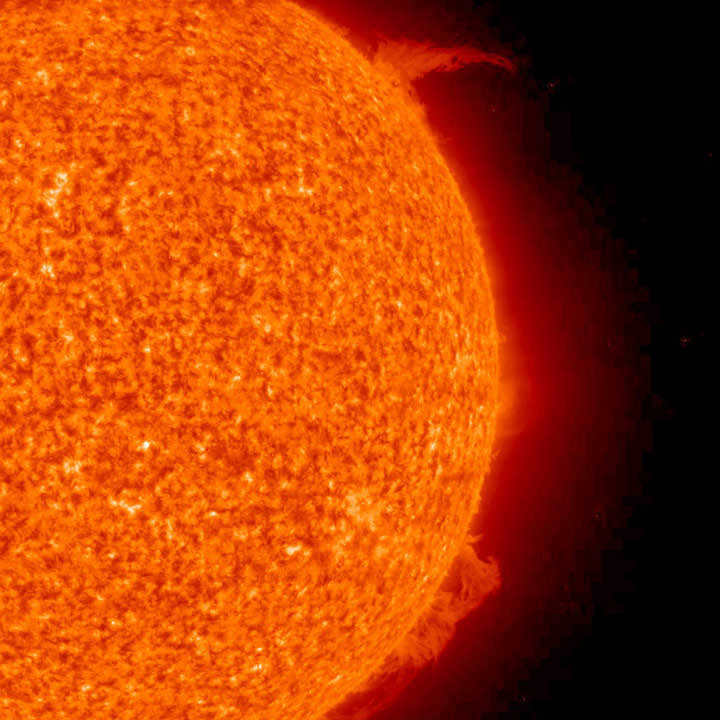
The origin and evolution of life on Earth was made possible by solar exposure. In the grand scheme of the Milky Way, the Sun is considered average in size, as approximately 80% of all stars in the galaxy are red dwarfs and are around 10-50% the size of the Sun. The distance between the Sun and Earth is approximately 149.6 million kilometers or 8.31 light minutes. This implies that it takes 8 minutes and 31 seconds for a photon of light to travel from the Sun to our planet. If the Sun were to vanish, we would become aware of its absence precisely after this duration of time.
2. Proxima Centauri
Proxima Centauri holds the distinction of being the nearest star, excluding the Sun. It forms part of the triple star system known as Alpha Centauri. This celestial body is located at a distance of 4,244 light-years. Its existence was only revealed in the year 1915.
Proxima Centauri is classified as a small red dwarf star, belonging to spectral class M. Its mass and radius are nearly 10 times smaller than those of the Sun. Despite its close proximity, Proxima Centauri is nearly imperceptible to the naked eye, emitting minimal energy with a temperature of 3042 Kelvin.
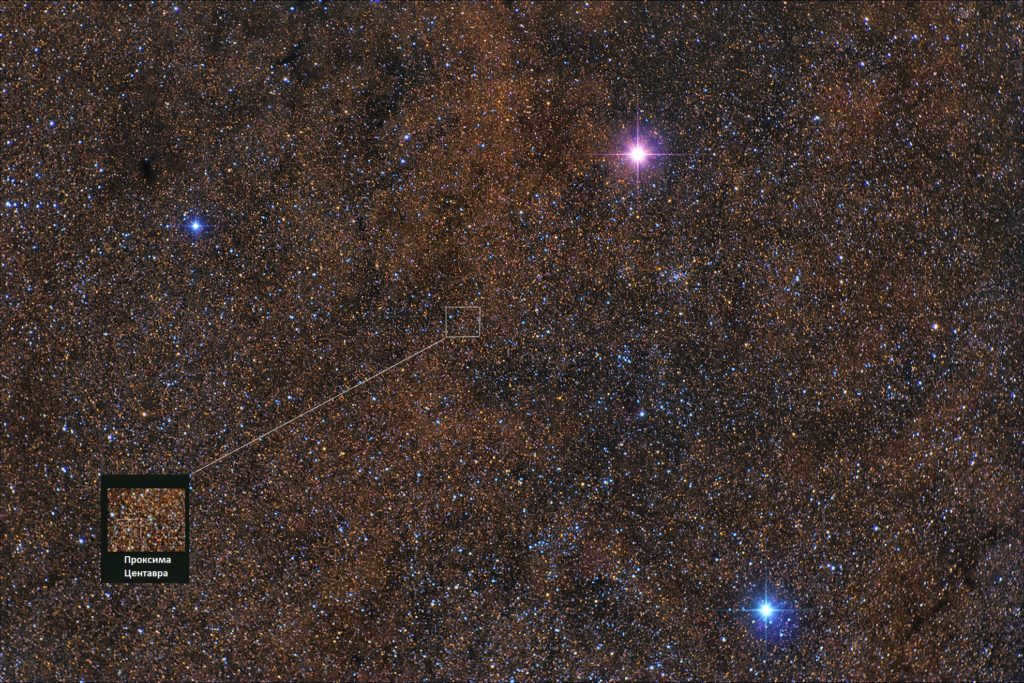
As stated earlier, Proxima Centauri is a component of a triple star system with an interstellar distance of 0.21 light-years. It maintains a gravitational connection with its colossal counterpart, Alpha Centauri A.
In 2012, researchers discovered that the system also harbors an exoplanet which is marginally larger in size compared to Earth. The possibility of sustaining life on this celestial body is eliminated due to its extreme surface temperature of 1200 o C.
3. Barnard’s Star
Edward Barnard discovered this star in 1916, and it was given his name. Barnard’s Star is classified as a red dwarf and is located in the constellation of Serpentor. Its distance from Earth is approximately 5.96 light years. In terms of mass and diameter, it is only 0.17 times that of the Sun.
An intriguing fact about Barnard’s Star is that it is currently moving towards Earth at a rate of 10.36 angular seconds per year. This indicates that by the year 11800, it will become the closest star to us (excluding the Sun), with a distance of 3.8 light years.
As of now, no known planets have been discovered in the vicinity of this celestial body.
4. Luhmann 16.
The star is part of a binary system comprised of two brown dwarfs. Situated in the constellation of Vela, this celestial object is approximately 6.516 light years away from Earth. Both stars in this system have masses ranging from 0.4 to 0.5 times that of our Sun. Luhmann 16 was initially detected by astronomers in 1978.
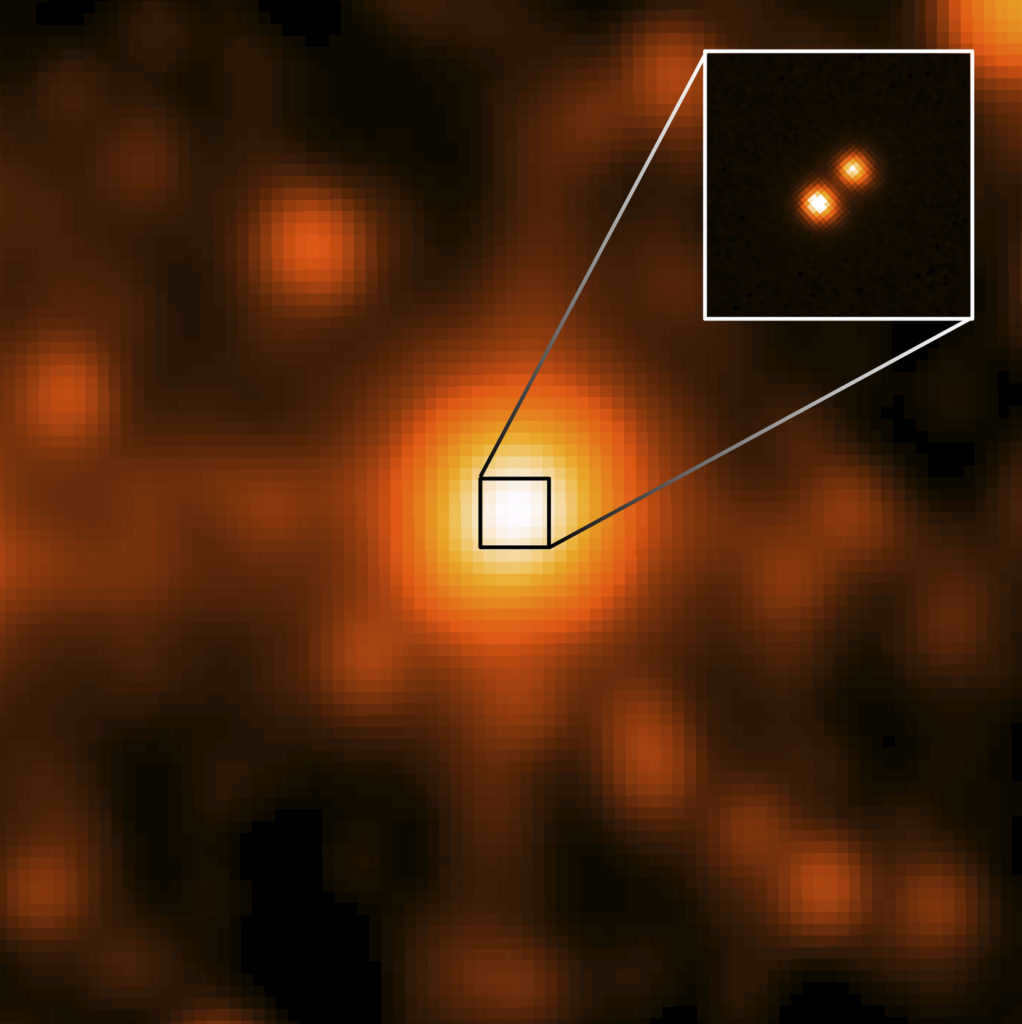
5. Wolf 359
Wolf 359 is a solitary young celestial body that forms part of the Leo constellation. Its proximity to Earth is measured at 7.78 light years. This diminutive red dwarf can only be observed through the lens of a telescope. It possesses a mass equivalent to 0.1-0.13 of the Sun’s mass and has a radius measuring 0.16-0.19 times that of the Sun.
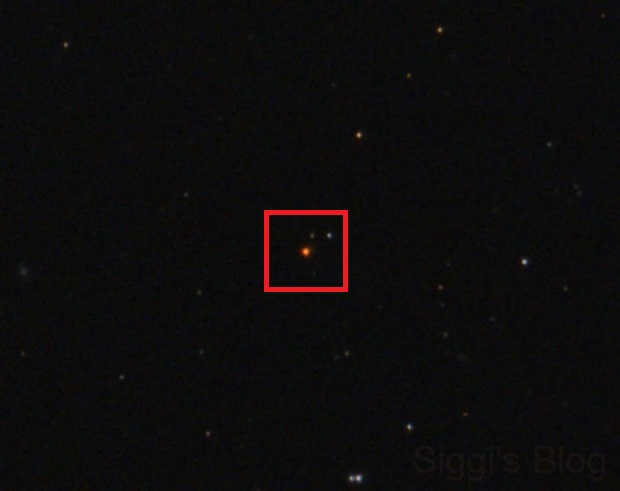
6. Laland 21185.
Laland 21185, also known as Wolf 359, was first observed in 1801 by the French astronomer J. Lalande, who named it after himself. This celestial body is a small star that belongs to the Ursa Major constellation, commonly known as the Big Dipper. Its distance from Earth is approximately 8.31 light years.
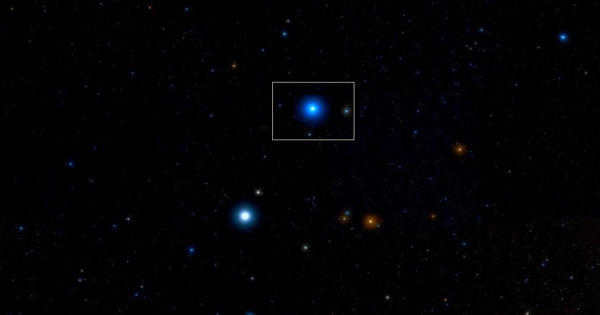
Astronomers have estimated the age of the star to be around 10 billion years. Prior to 2010, it was believed that there were three planets in close proximity to Laland 21185. However, recent analysis of radial velocities has disproven this theory. The star has a mass of 0.46 and a radius of 0.39 in comparison to the Sun’s corresponding indicators.
7. Sirius
Sirius is undoubtedly one of the most renowned stars in existence, renowned for its brilliance in the night sky. It has been a prominent celestial object since ancient times, with the Egyptians even venerating it as a god. Furthermore, it is also referred to as Alpha of the Canis Major constellation.
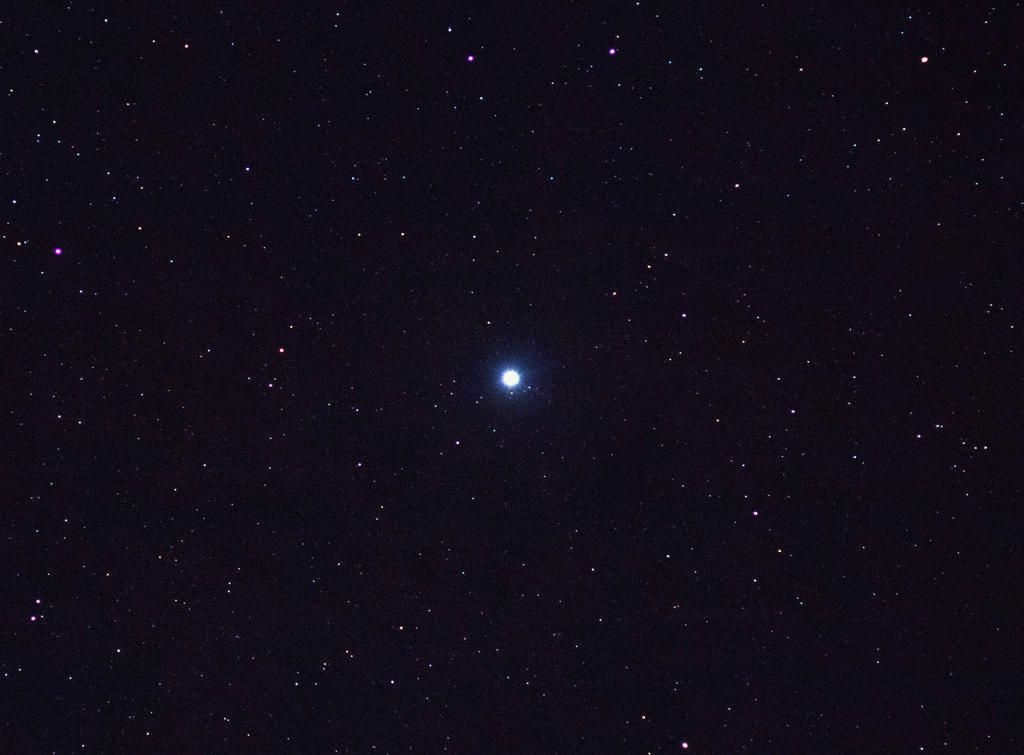
The distance from our planet to the Sirius star is 8.6 light years. It is a binary system that consists of a white dwarf called Sirius B and a star of A1-class called Sirius A. The age of this star system is 238 million years. In terms of mass, Sirius surpasses the Sun by a factor of 2. As for its radius, it is equivalent to 1.7 times the radius of the Sun.
Despite being ranked seventh, this star can be easily observed without a telescope. This is attributed to its high temperature and brightness. Scientists predict that the luminosity of this star will only increase in the future.
8. Leiten 726 8.
Leiten 726 8 is a binary star system composed of two red dwarf stars, each with a mass less than 0.12 times that of the Sun. It is located at a distance of 8.73 light-years from Earth. The stars are gravitationally bound to each other and orbit around their common center of mass, completing a full revolution in 26 years.
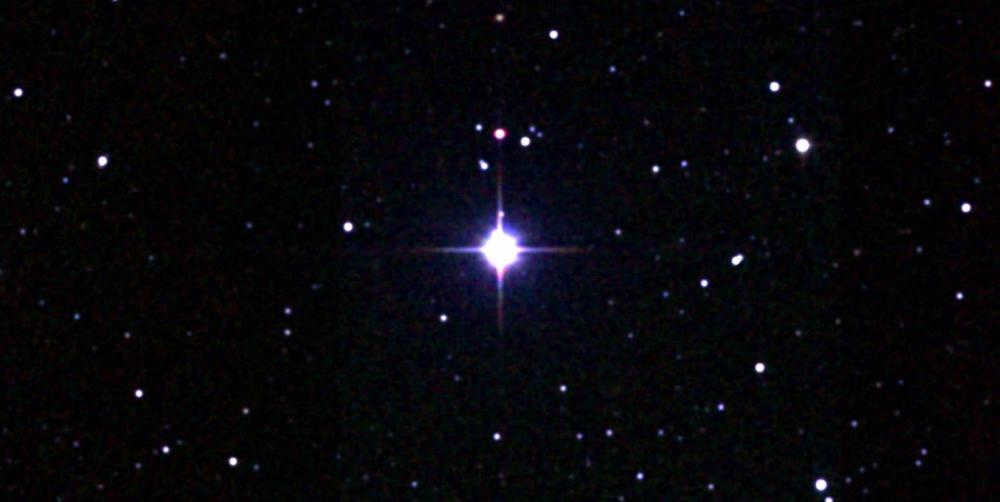
Did you know that in 1952, a team of researchers observed a star that experienced a 20-second flash, causing its brightness to increase by 75 times?
9. Ross 154
Ross 154, located in the Sagittarius constellation, is another red dwarf. Its distance from Earth is approximately 9.69 light-years. This star exhibits a variable luminosity and was first observed by Frank Ross in 1925.
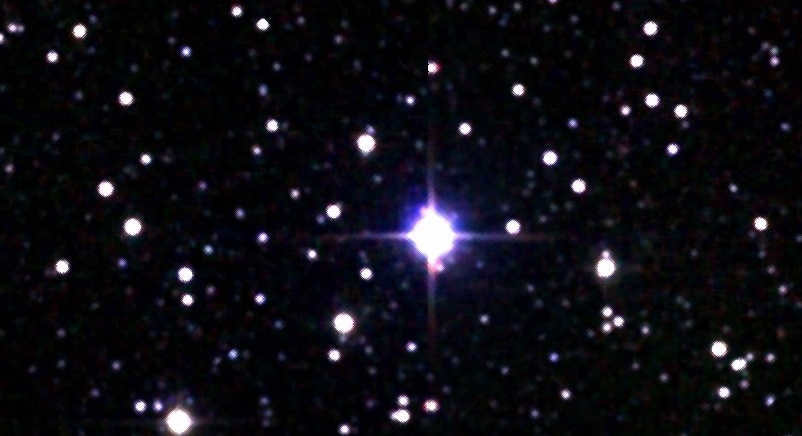
One notable characteristic of this celestial body is its intense X-ray emission, which surpasses that of the Sun. However, despite its high X-ray output, the star has a much smaller mass, only 0.17 times that of the Sun, and a smaller radius, only 0.24 times that of the Sun. Due to its distant location and faint luminosity, it cannot be observed without the aid of a telescope.
10. Ross 248
Ross 248, which is also referred to as HH Andromeda, is a red dwarf star located at a distance of 10.3 light-years. With a radius equivalent to 0.16 times that of the Sun and a diameter of 0.12, Ross 248 exhibits variable luminosity, experiencing flares and periods of fading.
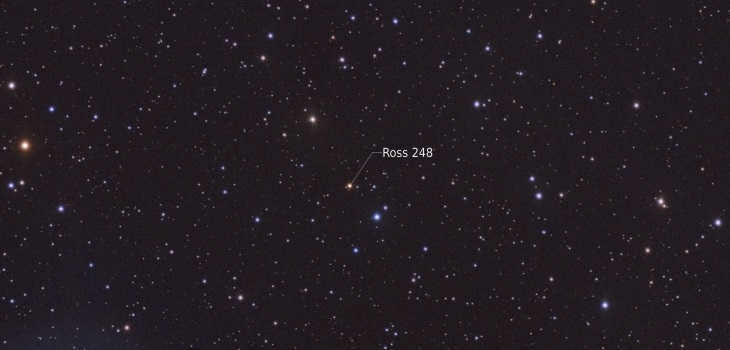
According to experts, the solar system is currently experiencing the rapid approach of a star. In approximately 36,000 years, the nearest stars to Earth will be our very own Sun and the fascinating Ross 248. In fact, there is an ongoing initiative to launch a scientific probe to investigate this celestial body.
Measuring the Distance to the Nearest Stars: The Role of Parallax
When it comes to determining the distance to celestial objects, modern astronomy relies on the concept of parallax. This method involves observing the apparent shift in position of an object against a distant background as the observer’s location changes. To get a sense of how parallax works, try this simple exercise: extend your arm and point your finger at an object in front of you. Now, open and close your eyes one after the other. You’ll notice that the object appears to shift its position slightly – this is parallax in action. Of course, measuring distances in the vastness of outer space is considerably more complex, but this example serves as a visual aid for understanding the concept of observing objects from different vantage points.
In order to make precise calculations of distances, scientists observe stars from various locations on Earth’s orbit (during winter and summer). When taking into account the planet’s displacement, the angle of inclination towards the observed object also changes with respect to the background. By utilizing parallax angles, researchers are able to accurately determine distances to stars within a range of 100 light-years.
The universe is a fascinating and relatively unexplored realm that is filled with many intriguing phenomena. Despite our advanced technology, our capabilities are still minuscule compared to the vastness of the cosmos.
If you were to inquire about the star in our solar system that is closest to Earth, the answer would be the Sun.
The Sun, located at an average distance of 1 astronomical unit (approximately 150 million kilometers), is the nearest star to our planet. It takes about 8 minutes for light from the Sun to reach Earth. One unique characteristic of the Sun is that it can be observed by Earthlings even during daylight hours, unlike most other nearby celestial objects that are visible only at night. As a yellow dwarf star, the Sun is just as remarkable as its counterparts and is actually one of the most common types of stars in the Milky Way galaxy.
If we inquire about the nearest star to Earth outside of our solar system.
The nearest star to Earth is Alpha Centauri. It is located 4.37 light years away. This is the amount of time it takes for light to travel the distance between us at a speed of 300,000 km/s. Therefore, this closeness is relative, as the distance is vast and humans will likely not be able to traverse such immense distances in the foreseeable future.
Alpha Centauri is a unique star. It comprises of a binary star system, designated as A and B. These stars orbit a common center of mass every 80 years, with one star alternatively approaching us and then the other. Both stars bear resemblance to our sun, with the A component being slightly brighter and the B component slightly dimmer.
Both stars can be observed with the naked eye as a single entity, possessing a magnitude of -0.27, making it the third brightest star in the Earth’s sky.
However, it’s even more intricate than that, and components A and B – Alpha Centauri – are not presently our nearest stars. There exists a third star in this system known as Proxima Centauri.
Proxima Centauri holds the title for being the star closest to Earth
Proxima Centauri is a red dwarf that is also a part of the triple star system Alpha Centauri. However, it is situated quite far from the two primary and larger components of the system – it is 15,000 astronomical units away, which is equivalent to 0.21 light-years. It’s worth noting that this distance is only 20 times shorter than the distance to Earth.
Due to the significant distance from the system’s center, Proxima Centauri completes an orbit every 500,000 years. At present, it is situated in the portion of its orbit that lies ahead of Alpha Centauri. As a result, Proxima Centauri will remain the nearest star to Earth for the coming millennia. However, once it transitions to a more distant section of its orbit, Alpha Centauri, including its A and B components, will assume the position of the closest star.

Proxima Centauri, which is situated in the sky, is positioned at a distance of 2.2 degrees from Alpha. This can be visualized as being equivalent to four lunar disks. However, it cannot be observed with the naked eye due to its brightness level of 11 m. Therefore, the only way to locate this nearest star to Earth is by using a telescope, even if it is a small one.
List of the nearest stars to Earth
Also included in the group of stars closest to our Sun are:
- Barnard’s star, a red dwarf located approximately 6 light-years away from us in the Serpentor constellation;
- The Luhmann-16 system, consisting of two brown dwarfs, positioned at a distance that would take a beam of light 6.5 years to travel;
- Wise-0855, a brownish and cold dwarf discovered in 2014 by the Wise orbiting infrared telescope. It was named in honor of the telescope and is situated about 7.3 light-years away from us with a negative surface temperature of -30°C;
- Wolf-359, a red dwarf that is still not extensively studied and is located at a similar distance from the Sun;
- Laland-21185 (also known as Gliese-411), a large red dwarf situated 8.3 light years away in the Big Dipper constellation.
- Sirius, which consists of two distinct bright objects, is known as the alpha star of the Canis Major constellation, and it takes light approximately 8.5 years to travel to reach us;
- Leiten-726-8 is a binary system composed of two red dwarf stars, and it pulsates at a distance of 8.7 light-years away from our Sun;
- Ross-154, an adolescent red dwarf located in the Sagittarius constellation, requires around 9.7 years for light to travel the distance to reach it.

Anticipating Future Changes
Moving through the vast expanse of the Universe, stars are constantly in motion. Among them, Barnard is the fastest of all, earning itself the nickname “Flying”. In the next 10,000 years, this celestial body will draw closer to us, reducing the distance between us to approximately 3.8 light years, which is about twice as close as it is now. However, in a longer time frame of another 33,000 years, the nearest star to Earth will be Ross-248, a faint red dwarf located in the Andromeda constellation. Currently, it is situated approximately 10.5 light years away from us.
In 1.35 million years, Gliese-710 will make its way towards the solar system, located 4 light years away. Currently, this distance is 11 times greater than its future proximity. However, some experts suggest that this orange dwarf will come even closer, just 1 light moon away. Although it will be thousands of times farther than the Sun is currently, it will still be significantly closer than any other star.
Once Gliese-710 reaches our vicinity, it will become the most prominent object in the night sky after the Moon and Venus. However, this approach may have some negative consequences. For instance, there could be disturbances in the Oort cloud, causing comets to deviate from their orbits and potentially collide with Earth. Such events could lead to mass extinctions and other catastrophic events on our planet.
How to calculate the distance to the nearest stars
The measurement of distance to celestial bodies relies on the concept of parallax in modern astronomy. This method involves observing the change in position of the object under study relative to the distant background and the observer’s location. To visualize this, extend your arm and point your finger at a specific object. Now, open and close your eyes alternately. You will notice that the object appears to shift its position – this is parallax. In space, the process of measuring distances is more complex, but this simple example demonstrates the idea of observing an object from different vantage points using a background.
The vast expanse of space is an awe-inspiring and enigmatic domain, brimming with a multitude of captivating phenomena. Despite the considerable advancements in technology, our understanding of the universe remains limited, highlighting the infinitesimally small nature of our capabilities.
NASA has provided a compilation of the nearest stars to our planet (excluding the Sun). The compilation encompasses stars from 53 different systems, which denotes the spectral classification of these stars (O, B, A, F, G, K, M, D, T, Y, L), the designation of the systems in which they reside, the light-years separating them from Earth, and the count of exoplanets detected in their vicinity.
The spectral classification of the stars follows a descending order of temperature: from bluer (hotter) to redder (cooler) – O, B, A, F, G, K, M, and so forth.
The nearest stars to our planet are three stars situated approximately 4.37 light-years away in the Alpha Centauri triple star system. These stars belong to the M, G, and K spectral types. Among them, Proxima Centauri (M – Red Dwarf) is the closest, lying just 4.24 light-years from us.
A single light-year is roughly equivalent to 9.46 trillion kilometers (5.88 trillion miles).
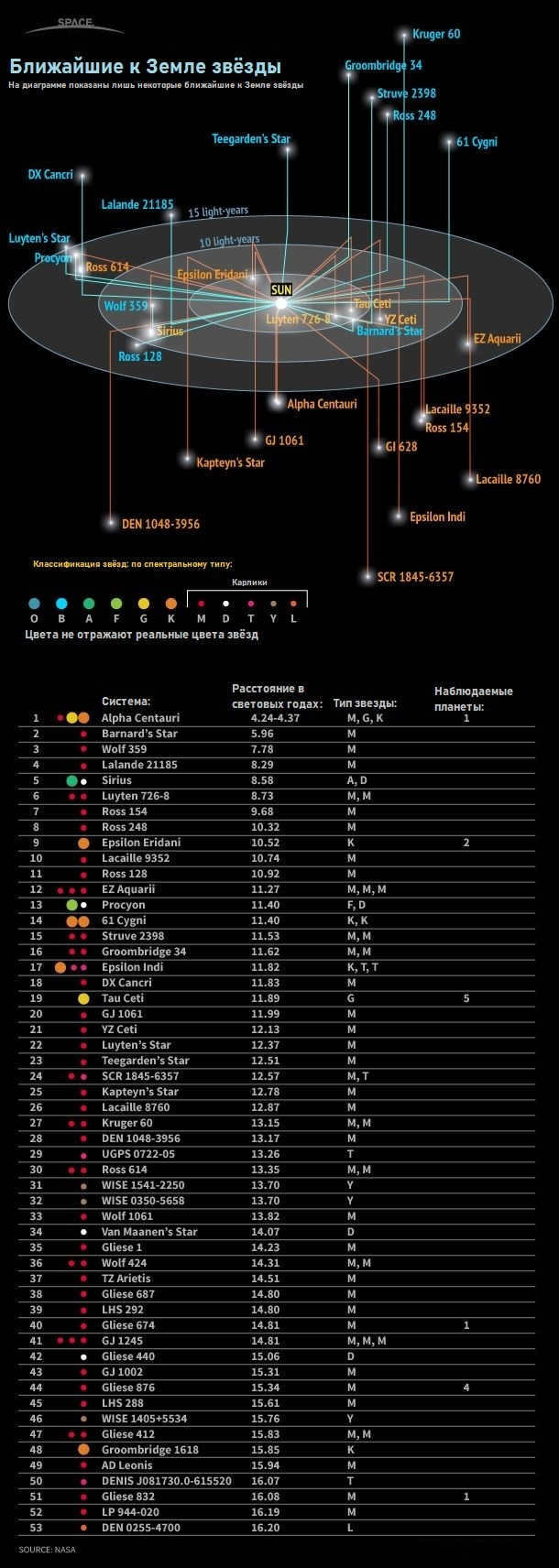

14.9K posts 45.3K followers
Guidelines for the Community
What regulations can be implemented here, apart from the regulations established by the peekaboo itself 🙂
Moreover, 39 light years away from Earth lies the binary star Zeta Setka, which is orbited by the unforgettable LV-426.
Additionally, Segmentum Solar is on the horizon.
You can now explore all the entries on this list, as well as another ten billion star systems, in the space game Elite Dangerous.
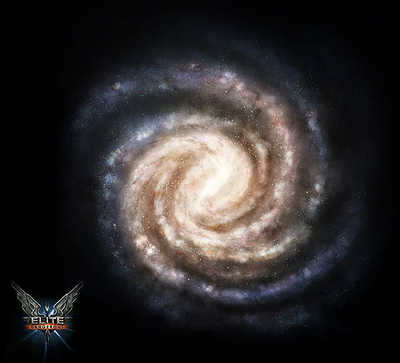






The cartographic representation reminds me of the radar used in the game Elite. Specifically, the version designed for the BBC Micro or ZX Spectrum.
During my time in school, I developed a strong passion for the field of astronomy.

Understanding the Mechanisms of a Planned Economy: Insights from Alexei Safronov
Have you ever wondered how exactly a planned economy operates? What does the process of nationwide economic planning entail? And what is meant by the term “planning to the nut”? In addition, how did the Gosplan of the USSR gather and analyze information regarding the country’s needs in terms of goods and services, and how did it ensure the effective implementation of the national economic development plan? Furthermore, what were the different stages involved in the planning process, and how were key decisions made? Lastly, was fashion also subject to planning in the USSR?
Alexei Safronov, an accomplished historian, economist, and PhD in economics, serves as a researcher at the Laboratory of Actual History within the Institute of Social Sciences at the Russian Academy of National Economy and Public Administration.

A fresh arrival: comet C/2023 P1 (Nishimura)
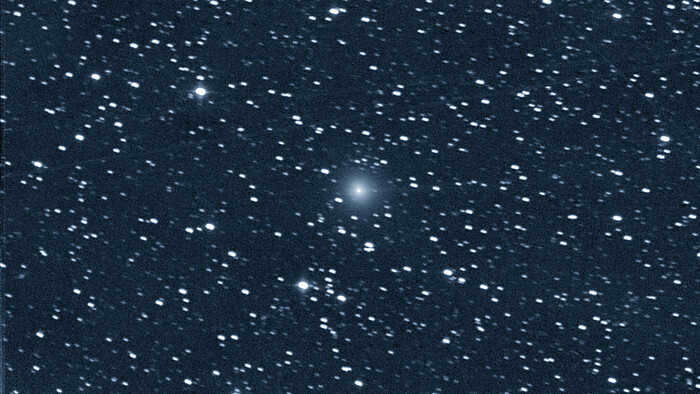
Comets are unanticipated visitors. If the ancient ones – well recognized by us – can simply disappoint annoyingly (which is not really surprising, considering that they have had time to deplete, dissolve upon repeated approaches to the Sun), then suddenly discovered novel comets are frequently vivid, impressive. However, this is not always the case.
The discovery of the comet C/2023 P1 was made by Hideo Nishimura, a Japanese astronomer, during the night of August 11-12, 2023. This comet is currently located in the constellation Gemini. It can be said that the discovery of this comet was a stroke of luck, as it is quite difficult to find a faint and nebulous object of such low magnitude (12th magnitude) in the rapidly brightening predawn sky. This discovery serves as a testament to Nishimura’s exceptional professionalism and dedication to his field.
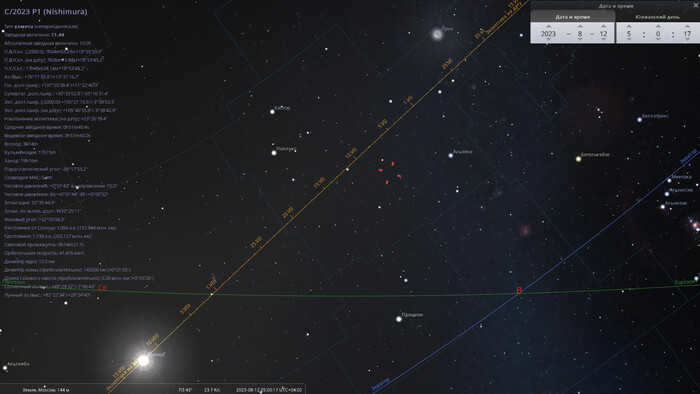
The position of comet C/2023 P1 in the Gemini constellation (at the time of its discovery) on the morning of August 12, 2023.
However, the brightness of the comet has increased with each passing night. Now, just a week later, it has already reached a magnitude of 10 stars. It is now visible through medium-power amateur telescopes. Although the visibility of Nishimura’s comet is still best before dawn, the overall seeing conditions have slightly improved since its initial discovery.
What Comes Next?
On September 18, 2023, the comet will reach perihelion (the point in its orbit closest to the Sun) at a distance of 33 million kilometers from its glowing surface. This is approximately twice as close as Mercury. However, it is important to note that Mercury is a solid planet, while the comet is made of ice. As a result, the ice will start to melt and vaporize well before reaching perihelion. This process is already underway, and astronomers have observed a small tail (measuring only 8-10 angular minutes in length) consisting of gases and dust emitted from the heated core of the comet.
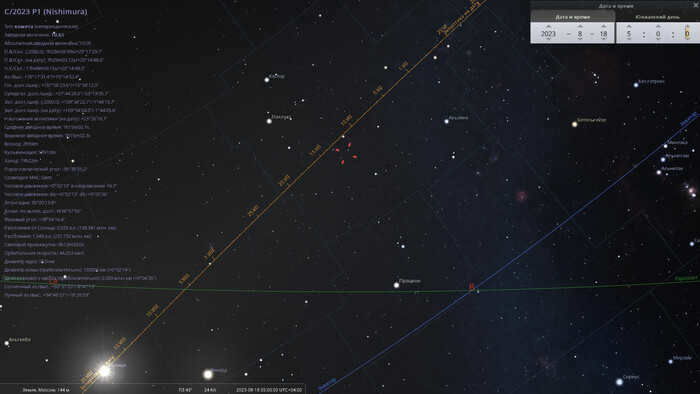
On the morning of August 18, 2023, comet C/2023 P1 can be found in the constellation Gemini.
Currently, the comet is in the process of crossing the Earth’s orbit and is located on the opposite side of the Sun from our perspective. As a result, the distance between the Earth and the comet is quite substantial, measuring one and a half astronomical units. However, this situation is rapidly evolving.
By the beginning of September, the Earth will be only 1 astronomical unit away from the comet (and the comet will be only half an astronomical unit away from the Sun). Although the distance between the Sun and the comet will decrease slightly (from 35 to 30 degrees), this will be balanced by the increasing difference in declination. As a result, the comet’s tail will be visible directly above the Sun, providing an excellent opportunity to observe it before sunrise.
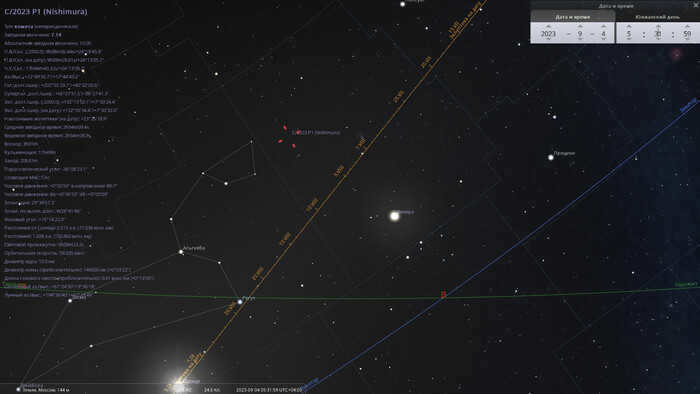
In the constellation of Cancer, on the morning of September 4, 2023, you can find the comet C/2023 P1. It will be positioned near the border of Leo, specifically near the asterism known as the “Lion’s Head,” which serves as a great reference point for locating it. Additionally, the bright planet Venus will also be visible in the same constellation. With a magnitude of 7, the comet will be easily observable with binoculars.
On September 9, 2023, in the morning, comet C/2023 P1 will be located 1 degree (west) from the star Adhafera (Zeta Leo). Its brightness will reach a magnitude of 6, making it visible to the naked eye in areas with optimal conditions such as mountains, deserts, or steppes.
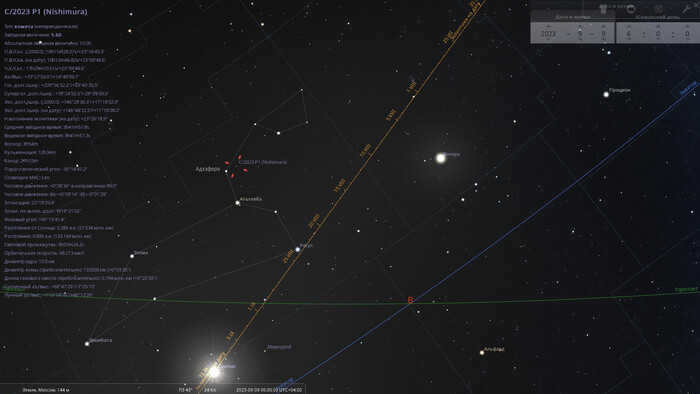
On September 9, 2023, comet C/2023 P1 will be located in the Leo constellation.
Regrettably, the angular distance from the Sun will decrease to 22 degrees, but the comet will ascend even higher above the ecliptic. Despite this small elongation, the comet will remain visible for at least one and a half (and possibly up to two) hours.
In the following days, the comet’s brightness will continue to increase, but its angular distance from the Sun will decrease, making observation conditions more challenging.
On September 12, in the morning, the comet’s brightness will reach a magnitude of 5 stars, while its elongation will decrease to 17 degrees. Meanwhile, the comet will still be positioned above the Sun, providing an opportunity to locate it in the morning twilight near the star Zosma (Delta Leo).
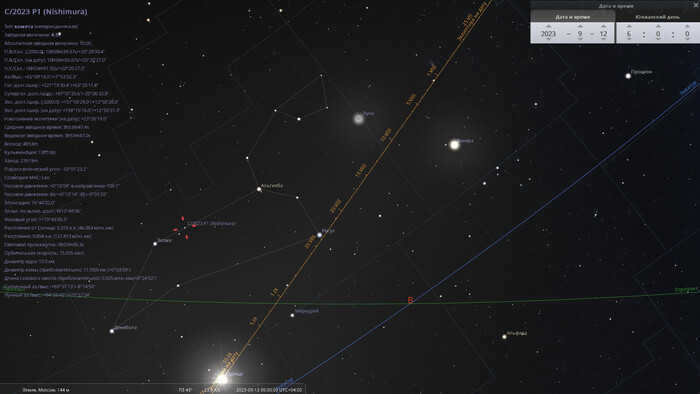
On September 12, 2023, in the constellation Leo, you can observe the position of comet C/2023 P1 in the morning sky.
By September 15, the comet will be getting closer to the 2nd magnitude star Denebola (Beta Leo). Although the comet itself will only be slightly dimmer, around the 3rd stellar magnitude, it will still be quite challenging to spot both objects against the brightening dawn sky.
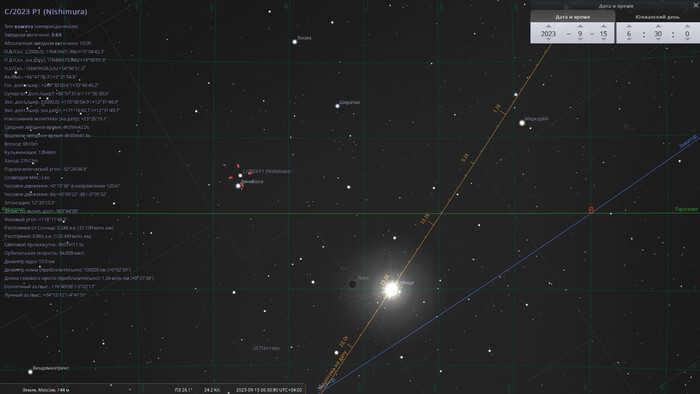
The location of comet C/2023 P1 in Leo on the morning of September 15, 2023
During perihelion, it is expected that the comet will have a brightness of approximately 2nd magnitude. In the evening, just a few minutes after sunset, observers in the northern hemisphere will be able to see the comet in the northern part of the Virgo constellation. However, in the southern hemisphere, it will be incredibly challenging or even impossible to spot the comet due to its higher declination compared to the Sun.
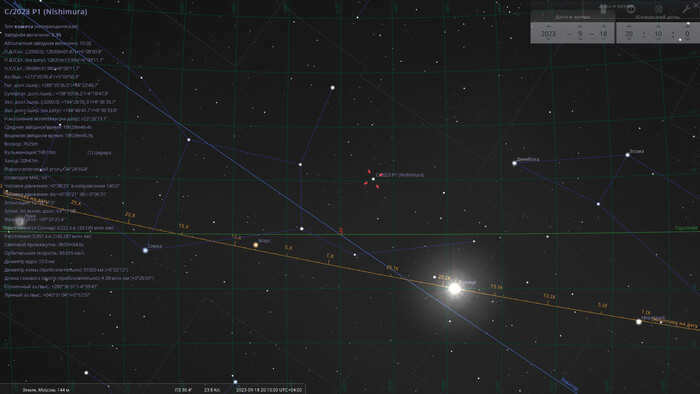
On the evening of September 18, 2023, comet C/2023 P1 (Nishimura) will be located in the constellation Virgo as it reaches perihelion.
As each day goes by, the comet will gradually move further into the southern celestial hemisphere and will cross the equator around the same time as the Sun – just a day before the autumnal equinox on September 21, 2023. The brightness of the comet will also decrease to 4.5m.
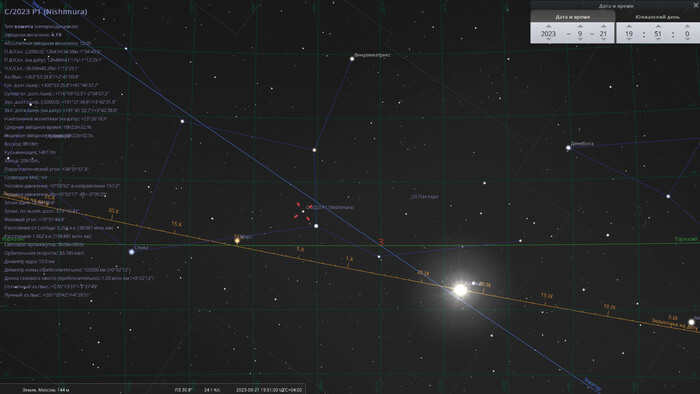
On the evening of September 21, 2023, you can find comet C/2023 P1 in the constellation Virgo.
Comet C/2023 P1 Nishimura will be visible on the evening of October 1, 40 minutes after sunset, at the border of the Virgo and Raven constellations. However, to observe it, you will need to be in Australia or the mid-latitudes of South America, or possibly at the southern tip of Africa. The comet will have a brightness of only about 7.5m, so it may not be worth buying tickets just for this event.
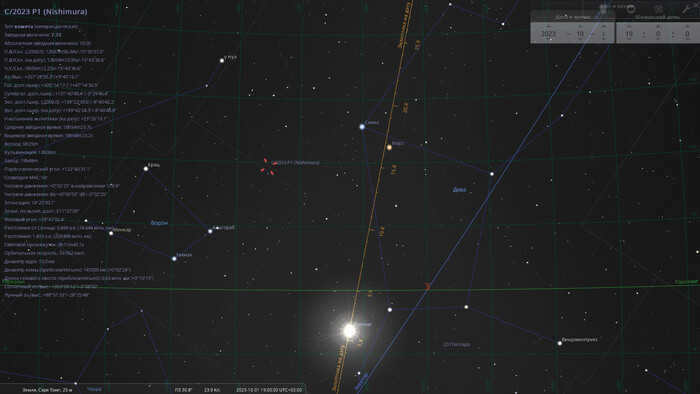
On the evening of October 1, 2023, comet C/2023 P1 can be found at the boundary of the Virgo and Raven constellations, according to observations from Cape Town, South Africa.
By mid-October, the comet will continue its journey further south, entering the tail part of the Hydra constellation. Its brightness will decrease to the 10th magnitude, making it difficult to observe even in the southern hemisphere. Eventually, the comet will become invisible to astronomy enthusiasts worldwide.
Not under our supervision. Currently, the orbital parameters have only been estimated. This level of precision is sufficient for predicting the comet’s position in the sky for the upcoming months, but even the duration of its orbit remains uncertain. Despite being categorized as a long-period comet, its orbit’s eccentricity is regarded as one, implying that the comet’s trajectory is nearly parabolic or possibly even such that it will not return to the Sun, potentially for millions of years or even indefinitely.
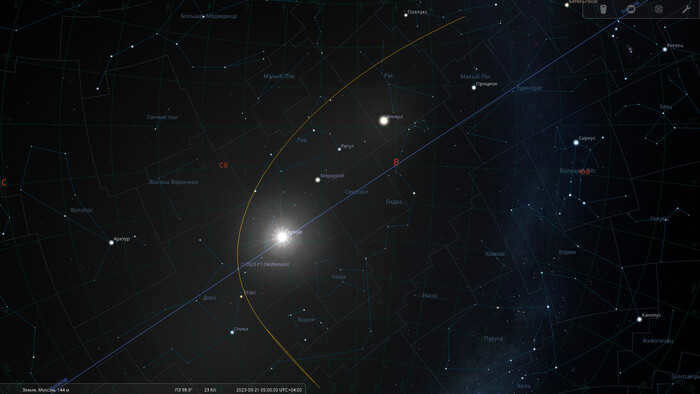
The path of comet C/2023 P1 Nishimura from August 12 to November 1, 2023.
All maps have been created using the software Stellarium

Constellation Cassiopeia
Cassiopeia is a constellation located 80 km from Minsk. The photo was taken with a Nikon d80+ Nikkor 50mm 1.8 lens.
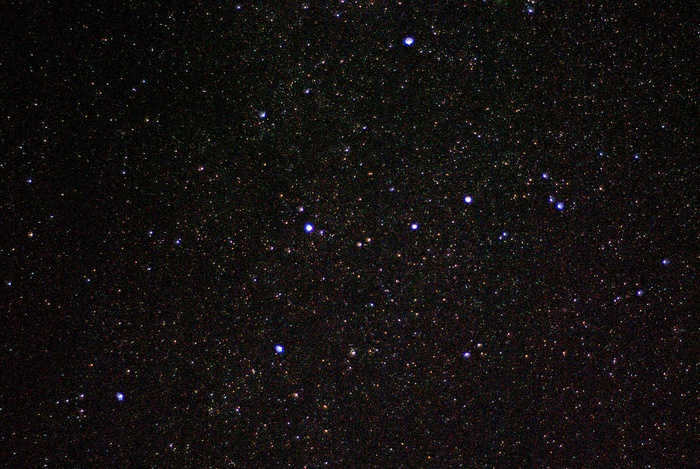
Who were the Soviets and how was the Soviet power structured – historian Gleb Targonsky Sciencepop
Who were the Soviets and how was the Soviet power structured? What is the origin of the term “Sovok”? Who were the creators of the Soviets and where did this governing body first appear? How were deputies elected and whose interests did they represent? How were Soviet deputies distinct from deputies in capitalist countries? Historian Gleb Targonsky provides insight into these questions.

Andromeda Galaxy
I made my initial attempt at capturing the Andromeda Galaxy through a telescope, but unfortunately, it didn’t go as planned. Despite setting a 30-second exposure, a dark cloud obstructed my view. Frustrated, I decided to take a picture using a tripod and a 50 mm lens, which yielded much better results. If anyone has experience in astrophotography through a telescope, I would greatly appreciate any advice on how to achieve desirable outcomes. My telescope, a Celestron 70lt az, is relatively inexpensive.
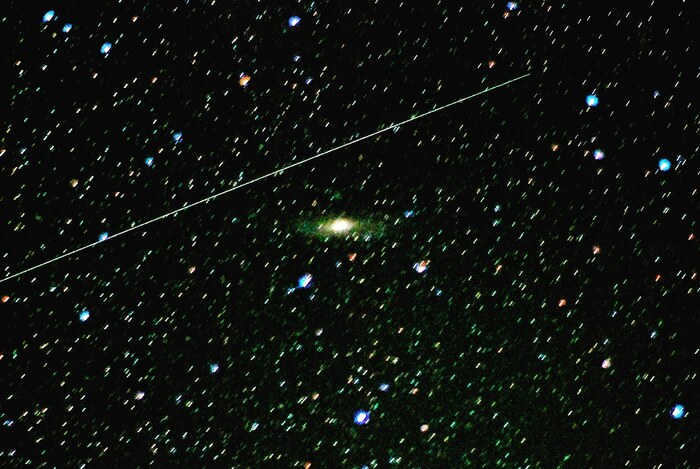
Discover the most alluring properties in our solar system
In 1957, the Soviet Union made history by launching the first-ever artificial satellite. Since then, many years have passed, and various space agencies, private companies, and research institutes have been expanding their presence in the solar system. The achievements they have made are countless, and it seems that there is plenty of space for everyone in this vast expanse. However, certain areas of “real estate” in space hold more allure than others. One such example is the Lagrange points, which have captured the attention of all interested parties. These points are named after the 18th-century mathematician who discovered their location and are highly valued for their unique stability in our ever-changing cosmos.
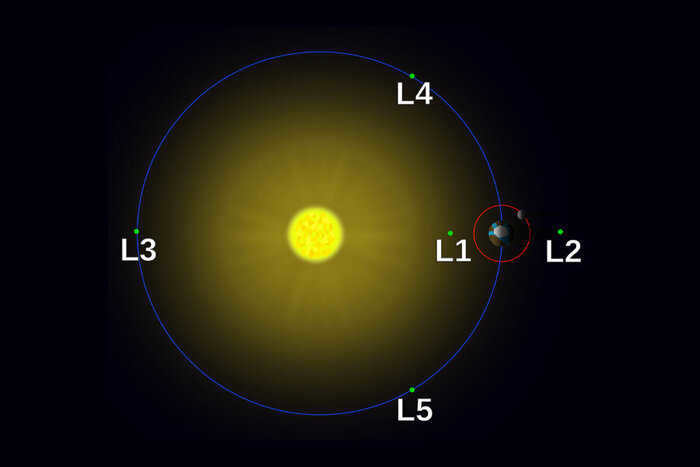
All celestial bodies exert gravitational influence on each other, with a particularly sensitive effect on nearby objects. In systems like these, the orbits of these “participants of motion” are determined by a combination of gravitational forces and other influences. At certain points known as Lagrangian points, these forces are perfectly balanced. This means that if a relatively small object is placed at a Lagrangian point, it will remain at a constant distance from the larger bodies, creating a stable island of motion. These zones are often referred to as “cosmic parking lots” because once an object is there, it requires very little energy to maintain its position. In essence, Lagrangian points are ideal locations for long-term space exploration and for the placement of man-made objects.
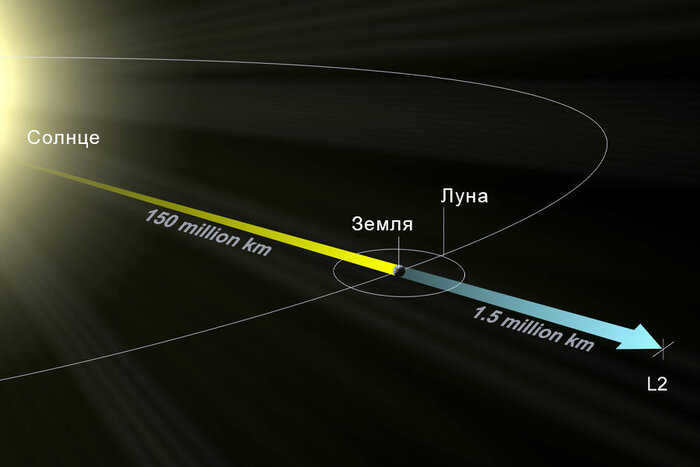
The issue of what can be placed in a specific Lagrange point is quite fascinating. Let’s focus on the ones formed by the gravitational interaction between the Sun and the Earth. L1 is situated approximately 1.5 million kilometers from our planet, between these two celestial bodies. Because the line of sight to the sun is never obstructed, it serves as an excellent location for solar observations.
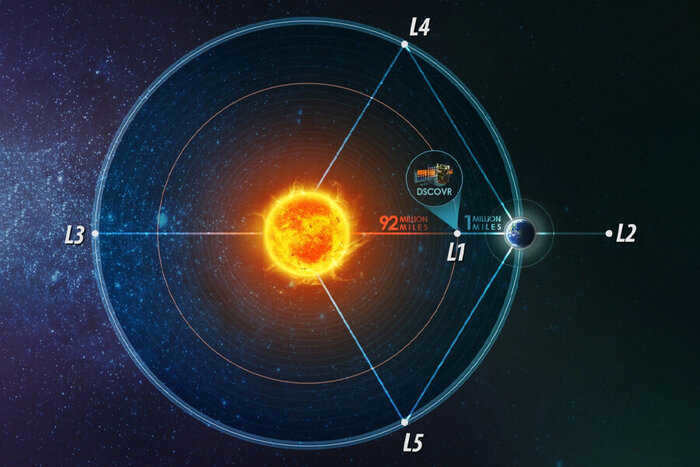
The Deep Space Climate Observatory is positioned at Lagrangian point 1, serving as an American spacecraft dedicated to observing both the Sun and Earth.
Lagrangian point 2 (L2) is situated on the opposite side of the Earth, equidistant from our planet. This strategic location ensures reliable protection from sunlight and offers unparalleled opportunities for observing space in the opposite direction. In 2022, the highly anticipated James Webb telescope embarked on its mission from this point, a moment that astronomers have eagerly awaited for two decades.
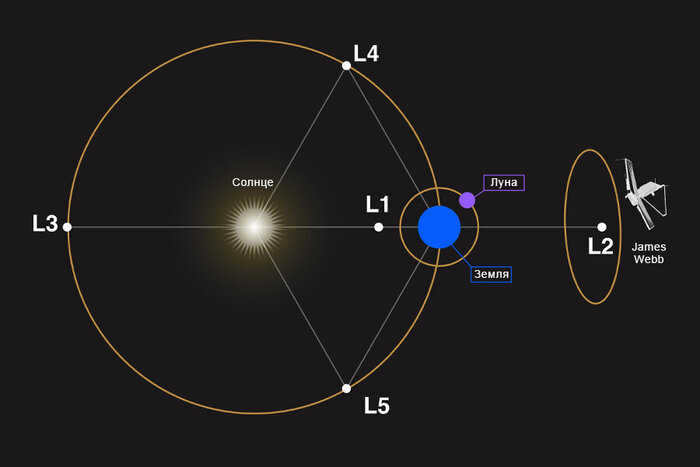
L3 is located in the most enigmatic region, situated on the opposite side of Earth’s orbit in relation to the Sun. This particular spot in the vast expanse of the Universe remains concealed from the planet’s surface, rendering it completely invisible even in theory. Consequently, it has become a popular subject among science fiction authors, while actual scientists find little practical application for it.
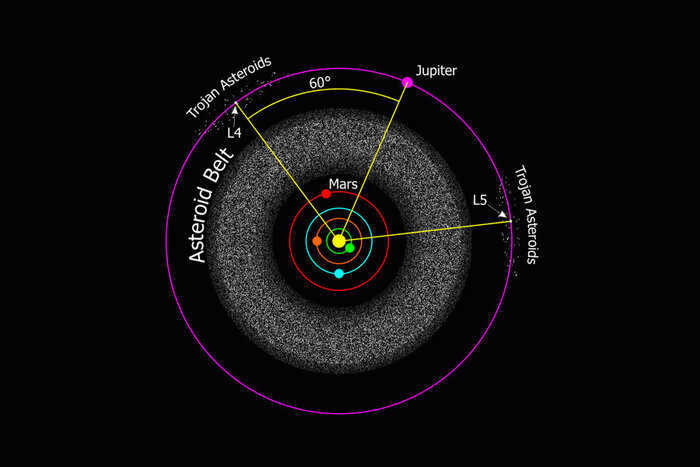
Each Lagrangian point in the solar system has its own unique characteristics. Some of them can be used for gathering construction materials, considering drifting asteroids as such. Others could serve as refueling stations for replenishing fuel for spacecraft traveling into deep space. Human colonies could potentially be established here as well. Of course, this is a matter of the distant future, a future that we may not live to see given the current state of affairs on Earth. However, there is no harm in dreaming, is there?
Thank you for your attention! If you enjoyed the article, you can show your support by giving it a “plus” or subscribing to this channel. We also want to mention that we have our own Telegram channel where we regularly share interesting posts about space and astronomy.
We deeply value all of our readers. If you are interested in providing us with financial assistance (using the button provided below), your name or nickname will be included at the conclusion of our upcoming post. This is our humble way of expressing our gratitude for your generosity and encouragement!
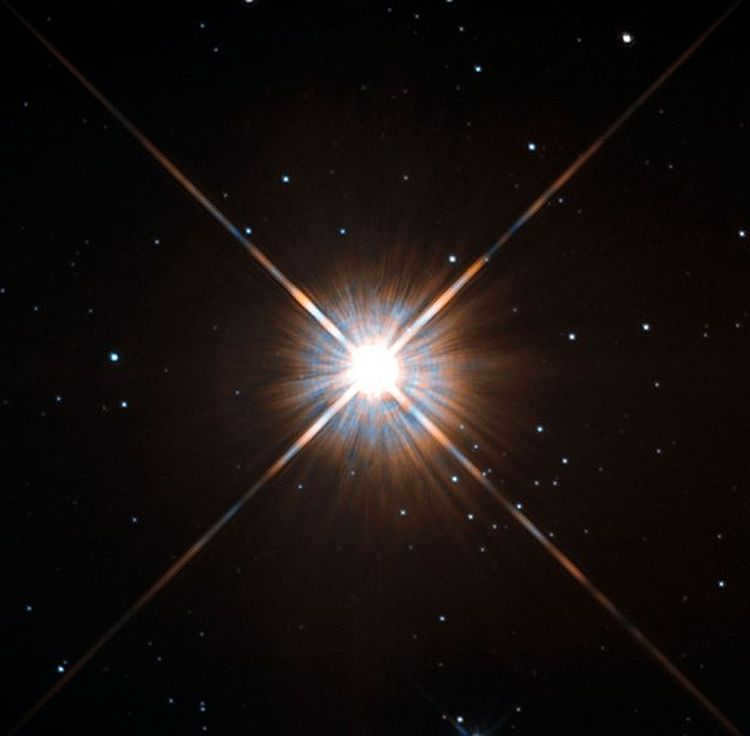
The nearest star to the Sun was found by Robert Innes in 1915 and given the name Proxima Centauri. Proxima Centauri is a red dwarf star that can be found in the Alpha Centauri system.
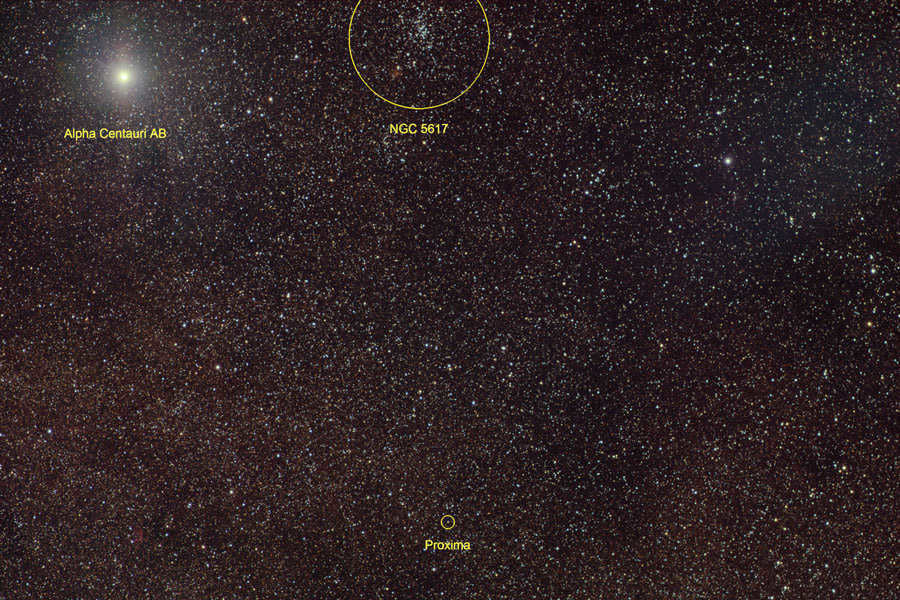
Proxima’s Description
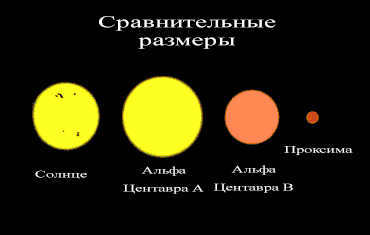
The star’s diameter is seven times smaller than that of the Sun, and its mass is also seven times smaller. Its luminosity is a mere 0.17% of the Sun’s luminosity, or a mere 0.0056% in the visible spectrum. This explains why it is invisible to the naked eye and why it was only discovered in the 20th century. The star is located 4.22 light years away from the Sun, which is relatively close in cosmic terms. Our Sun’s gravity extends to about half that distance! However, for humans, this distance is truly immense.
The measurement of the distance to Proxima Centauri
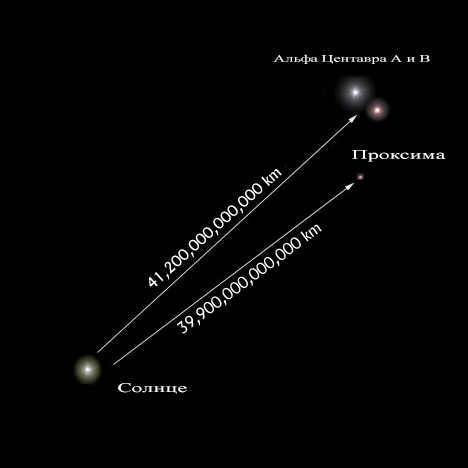
Distance to Proxima in kilometers
Distances on the scale of planets are typically measured in light-years. This unit represents the distance that light can travel in a vacuum within a period of 365 days, which is equivalent to approximately 9.64 trillion kilometers. To gain a better understanding of these immense distances, let’s consider a few examples. The distance between the Earth and the Moon, for instance, is approximately 1.28 light seconds, and with the aid of modern technology, it takes around 3 days to complete the journey. When it comes to the distances between planets within our solar system, they can range from 2.3 light minutes to 5.3 light hours. In simpler terms, the longest voyage between planets would take slightly over 10 years to complete in an unmanned spacecraft.
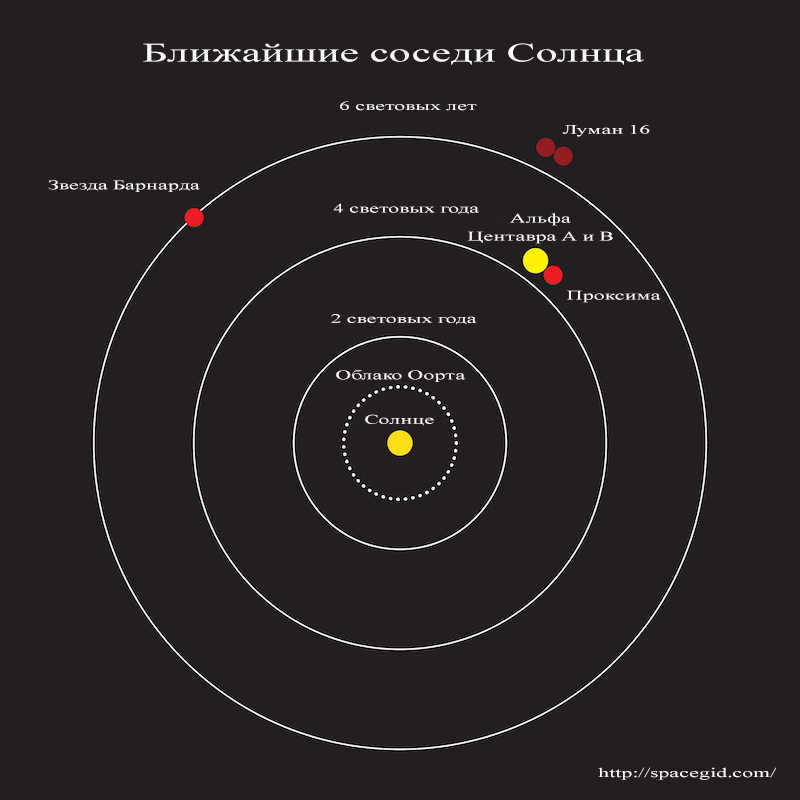
The nearest stars to the Sun
Let’s now contemplate the duration it would take for us to travel to Proxima Centauri. The current record holder in terms of speed is the Helios 2 unmanned spacecraft. It travels at a speed of 253,000 kilometers per hour, which is equivalent to 0.02334% of the speed of light. If we crunch the numbers, we’ll find that it would take us approximately 18,000 years to reach the closest star. Unfortunately, with our current technological capabilities, we can only sustain a spacecraft for 50 years.
Embarking on a journey to Proxima Centauri

